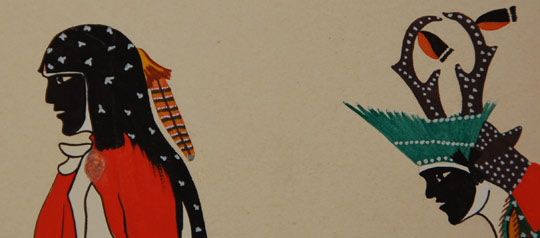Adobe Gallery Blog
Subject: San Ildefonso Original Painting of two Dancers
Abel Sanchez, or Oqwa Pi, as he was known by his Tewa name, had very little art instruction except for a few classes he took at the Santa Fe Indian School.
Clara Lee Tanner in her book Southwest Indian Painting: A Changing Art says that Sanchez was noted in history for preserving and carrying on "many of the trends that might be thought of as 'native,' inasmuch as they were developed by Indians without any instruction."
Characteristic of Oqwa Pi's style, there were no backgrounds, foregrounds, or ground lines. The primary figures of his study were the only images on the paper.
The artist's subjects appear to be in action, but in a very subtle way. In this Oqwa Pi painting the dancer in the foreground appears to be walking and the Antelope dancer following him appears to be dancing. This sense of movement was very characteristic of his style. What is lovely about this painting is Oqwa Pi's use of bright colors. The overall detail of the artist's style is evident in the white knit leggings worn by the Antelope dancer and the green headdress he wears. Also the evergreen bough in the other's hand and the details of his moccasins are finely handled. While overall simplistic, he captures the spirit and mood of this wonderful Pueblo dance.
Condition: The painting was delivered to us without a frame so we were able to inspect it and we found no noticeable damage to the paper but there is a small red spot on the front dancer's shirt, where it overlaps the neck tie, that appears to have been professionally touched up with pigment. It has been framed using all acid-free materials and a simple dark wood frame. It is signed "Oqwa Pi" at lower right. The paint colors are still brilliant.
Provenance: acquired from a couple from Massachusetts.
Recommended Reading: Southwest Indian Painting: a Changing Art by Clara Lee Tanner.
Subject: San Ildefonso Original Painting of two Dancers
Artist: Abel Sanchez (1899-1971) Oqwa Pi - Red Cloud
Category: Paintings
Origin: San Ildefonso Pueblo
Medium: casein
Size: 9" x 12-3/8" image; 14-3/4" x 18-1/4" framed
Item # 25608


